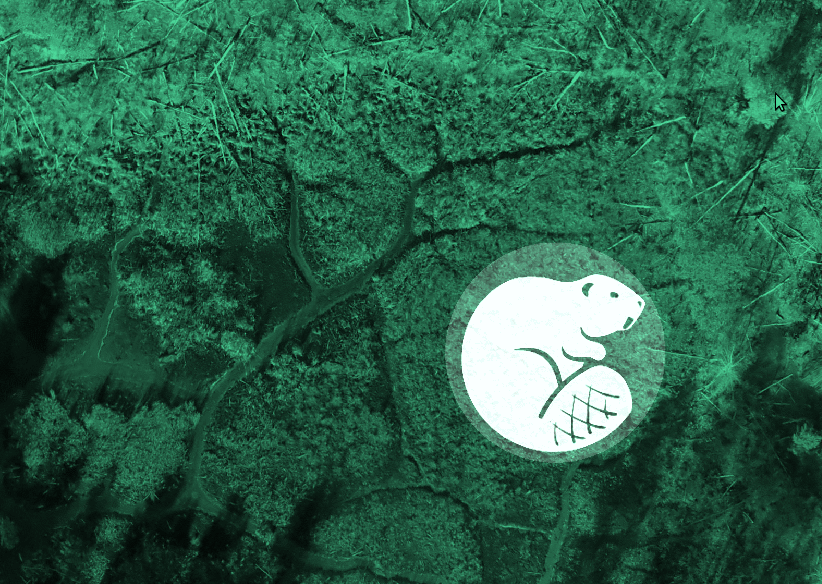
У багатьох країнах cвіту в умовах зміни клімату, деградації трансформованих водних екосистем, зменшення біорізноманіття увага дослідників сфокусована на бобрах. Чому? Тому що ці тварини здатні на дива! Присутність бобрів та створення ними водойм збільшує кількість птахів, земноводних, риб, зберігає та очищує прісну воду, сприяє підняттю рівня грунтових вод. Такі види, які здатні активно змінювати природні комплекси, називають екосистемними інженерами. Сучасні технології дозволяють поглянути на роботу бобрів з космосу, оцінити масштаби впливу та зробити прогнози змін.
Бобри живуть родинами від 2 до 10 особин. Молоді бобренята залишають рідну домівку після двох років. Зустрічаються і самотні тварини – молодий бобер, який не встиг знайти пару, або коли один з дорослих бобрів загинув. Родина бобрів займає територію, яку називають сімейною ділянкою. Вона охоплює водойму (або частину водойми, або кілька невеликих боліт та озер) та прибережну смугу. Розміри сімейної ділянки залежать від кількості та якості кормів, які мають забезпечувати життя бобрової родини. Харчуються тварини рослинами, які зростають у воді та на березі. Бобри будують хатки та риють нори. Восени вони готують одне зі своїх сховищ до зими – ремонтують, створюють неподалік у воді запаси гілок. Місце, яке бобри обрали для зимівлі, називають зимувальною ділянкою.
То як досліджують бобрів? Розглянемо це питання на прикладі Національного природного парку «Слобожанський».
Символом НПП «Слобожанський» є бобер європейський (Castor fiber) (рис.1). Тому не дивно, що співробітники установи приділяють особливу увагу цій тварині: проводять обліки чисельності, моніторинг популяції та оцінюють вплив на природні комплекси.

Рисунок 1. Емблема Національного природного парку «Слобожанський»
Щорічні обліки бобрів
Вже впродовж шести років НПП «Слобожанський» залучає волонтерів з усієї України до обліків чисельності бобра європейського. Обліки проходять протягом тижня у вигляді щоденних піших обходів лісових боліт та озер, ставків та ділянок річок (рис.2). За загальноприйнятою методикою вимірюються діаметри усіх дерев та кущів, які було погризано бобрами, і ширина слідів від різців. За отриманими даними розраховують чисельність та віковий склад сімейних груп бобрів на зимувальних ділянках.
Як визначити зимувальну ділянку? Учасникам треба відшукати боброву хатку зі слідами ремонту та запасами гілок у воді біля неї. Така хатка буде свідчити, що саме на цій водоймі тварини залишаться впродовж зими. Для орієнтації на місцевості та занотовування вимірів обліковці використовують мобільні пристрої та додатки (NextGIS mobile, ArcGIS Mobile) з набором підготовлених карт місцевості, спеціальні польові щоденники.

Рисунок 2. Під час обліку бобрів.
Волонтери, які приймають участь у обліках, мають можливість дізнатись багато цікавого про найбільшого гризуна Європи (рис.3). Вони обстежують боброві канали, погризані дерева, загати та величні хатки, які у НПП «Слобожанський» досягають більше 2 м заввишки. Ввечері учасники обговорюють оглянуті ділянки, складають план на наступний день та переглядають фільми про бобрів (наприклад «Боброва гребля» Джеффа Хогана).

Рисунок 3. Учасники обліків бобрів у 2016 році.
Моніторинг популяції бобра європейського
Польові дані, які були зібрані під час обліків чисельності, аналізує науковий відділ Парку. Співробітники відділу ведуть базу даних сімейних ділянок, оновлюють векторний шар просторового розміщення бобрових споруд та їх використання (рис. 4).

Рисунок 4. Розташування зимувальних ділянок бобра європейського у 2016 році.
Загальна чисельність бобрів у НПП «Слобожанський» коливається від 70 до 180 особин. За сприятливих умов тварини заселяють майже усі придатні водойми Парку. Життя бобрів перш за все залежить від стабільного рівню води, але на лісових болота та озерах НПП«Слобожанський» вони не мають можливості зберегти водойму за допомогою гребель. У такому випадку ключовими стають погодні умови. Науковий відділ веде спостереження за кліматичними показниками, рівнем води у лісових озерах за допомогою гідрологічних постів та зміною площі водного дзеркала з використанням супутникових знімків. Під час цих досліджень у нагоді стали знімки Planet, які були використані у рамках програми Planet’s Education and Research Program (Planet Team (2017) Planet Application Program Interface: In Space for Life on Earth. San Francisco, CA). (рис 5). За даними дистанційного зондування добре видно, що є водойми, які завжди пересихають, та водойми, які лише інколи пересихають у серпні-вересні.

Рисунок 5. Динаміка водного дзеркала лісових озер у НПП «Слобожанський».
Відображення у ГІС даних по розмноженню у родинах бобрів та виникненню нових зимувальних ділянок надає цікаву інформацію про розселення тварин та успішність використання територій (рис. 6).

Рисунок 6. Динаміка кількох поселень бобрів у НПП «Слобожанський».
Оцінка впливу на природні комплекси
Діяльність бобрів може кардинально змінити вигляд території. Щоб створити водойму, бобри будують греблі на невеликих струмках. Коли вода підіймається, вона затоплює значну територію. Історію виникнення бобрового ставка в околицях НПП «Слобожанський» можна прослідкувати за допомогою космічних знімків Landsat (рис. 7).

Рисунок 7. Бобровий ставок в околицях НПП «Слобожанський».
Доречі, найбільша боброва загата у світі знаходиться у Канаді. Вона має довжину більше 800 метрів.

Рисунок 8. Найбільша боброва загата, джерело зображення
В умовах пересихаючих лісових озер бобрам доводиться також докладати зусиль, щоб відновити водний режим. Вони риють канали, які добре видно під час зйомки з безпілотних літальних апаратів (БПЛА) та на високодетальних космічних знімках (рис 9). Активна риюча діяльність дозволяє затримувати дощову воду та піднімати рівень грунтових вод. Чи зможуть бобри врятувати болотні комплекси НПП «Слобожанський»? Співробітники парку сподіваються на своїх маленьких помічників.

Рисунок 9. Боброві канали за даними БПЛА.
Бобри харчуються рослинами, тому активно впливають на їх склад та кількість у прибережній зоні та воді. Вони здатні створити справжній лісоповал з осик та берез, розчистити озеро від заростання рогозом та очеретом. За оцінкою запасів їстівних видів можна розрахувати приблизний час існування бобрового поселення, дослідити динаміку природних комплексів. Для високо детального картування якнайкраще підходять дані БПЛА, особливо коли розмова заходить про оперативність та важкодоступні місця. Ось, наприклад, боброва хатка з висоти пташиного польоту:

Рисунок 10. Боброва хатка за даними БПЛА.
І на завершення, можна впевнено сказати, що бобри — надзвичайно цікавий об`єкт для досліджень. Він не залишає байдужим ні біолога, ні еколога, ні гіс-фахівця. А ви звертали увагу на діяльність бобрів поблизу вашої домівки?




